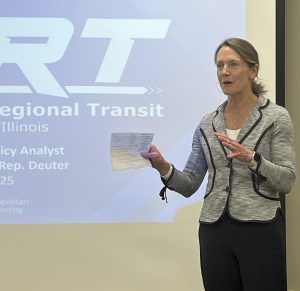Transit planning includes talk of taxing services
By Bill Dwyer For Chronicle Media — April 20, 2025
State Rep. Marti Deuter, D-45th, speaks Tuesday at an informational event on mass transit in northeastern Illinois at her district offices in Westmont. (Photo by Bill Dwyer/for Chronicle Media)
Marti Deuter, who was elected 45th District state representative in November, picked a timely issue for the first event in her new speaker series.
Tuesday’s program was the first in a series of speaker events Deuter has planned, intending to engage her constituents in state and district issues, and “foster an open dialogue with residents.”
“We want to (identify) big meaty issues and bring them to the district,” Deuter told her audience. “Public transit, in my opinion, is one of the big issues.”
Big and multi-faceted, with no easy answers, and some difficult choices to be made. To get answers, Deuter brought two officials from the Chicago Metropolitan Agency for Planning — Nikolas Merten, a policy analyst, and John Carpenter, intergovernmental affairs director — to her district office on Cass Avenue in Westmont
Merten noted that transit ridership has yet to recover from the COVID-19 pandemic, which lowered revenues drastically. Now, with a projected $730 million budget shortfall looming in 2026, when federal COVID-19 relief funds run out, the Regional Transit Authority must either find the money to cover that gap or face draconian service cuts of up to 40 percent that he and others have termed “devastating.”
Less transit options, he added, also would lead to greater congestion on the region’s roadways.
Merten said state officials have known the fiscal cliff was coming for some time. In 2023, they tasked CMAP with producing a report on the numerous issues related to public transit in northeastern Illinois, including improved service, reliable financing and reorganization.
Merten took attendees through the key points of CMAP’s comprehensive Plan of Action for Regional Transit, which is available online. The discussion also involved how to pay for both the projected shortfall and future system funding, with the likelihood that the state legislature will consider the previously rejected idea of applying the state sales tax not just to goods, but also consumer services.
Merten said the goal is to provide “more transit at more times in more places,” while ensuring good governance of the system throughout the region and securing stable, reliable funding sources.
He said the envisioned transit changes will “require a truly transformational investment.” As in $1.5 billion in new public operations investment. It is an investment, he said, that must be shared by all stakeholders.
“The transportation system itself must come up with substantial revenues. And the state should provide more robust support.”
“The agencies have to commit to containing cost growth, and they also have to commit to raising fares,” said Merten. “Success requires everyone to contribute.”
Merten suggested a “suite of options,” for new funding, including a vehicle registration surcharge, though the most notable option was changing Illinois’ sales tax system to include certain services. He said the service taxes would be on retail services only, not business to business.
In a separate but related report, “Modernizing Illinois’ Sale Tax,” CMAP called the state’s sales tax system a “critical but slow growing revenue source.” Merten noted that while some states, like Iowa, have an overall lower sales tax rate, those states benefit from having a much wider sales tax base that includes services and not just goods.
Merten said it’s estimated that adding consumer services to the sales tax base would bring an additional $2 billion to the state, $400 million additional to the RTA and “hundreds of millions to local governments.”
That, he said, “could be a cornerstone revenue solution for the transit system.”
Adding some services to the sales tax base would also make the system fairer, Merten said, by “reduc(ing) regressivity” that impacts those of lower economic means the hardest.
“Poor people spend less on services than goods,” he said.
Another major change likely coming is to the organizational chart of transit agencies in the northeastern Illinois region. Merton said there are two options.
The first is to reorganize the RTA, Metra, PACE and CTA into one single “fully integrated, fully consolidated” regional transit organization, with one board.
“The transit agencies would become sort of operating subunits” of that agency, he said.
The second option is to have a single regional coordinating agency, but with three separate operational agencies, PACE, Metra and the CTA, that retain their own corporate structure.
Merten said CMAP has not taken a position on either option. Carpenter said two bills have been filed in the Illinois Senate, one covering each option; both are sponsored by State Sen. Ram Villivalam, chair of the Senate Transportation Committee.
The Metropolitan Mobility Authority bill, or MMA, would implement the PART report’s governance Option One, to create an integrated regional agency. A companion appropriations bill would fund at least $1.5 billion in annual transit operations.
After the MMA was filed a year ago, a coalition of labor groups calling itself the Labor Alliance for Public Transportation brought forward a second proposal that was filed in February, called United We Move Illinois.
Carpenter said the two proposals are being seriously discussed, and his best guess was that “whatever comes out of this will be some combination of both of those bills.”







